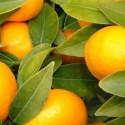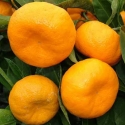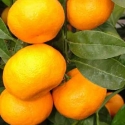Mandarin - Just Arrived
The blossoms of the mandarin are heavily perfumed and can be quite intoxicating in the evening.The fruit is oblate, rather than spherical, and roughly resembles a small pumpkin in shape. Mandarins are usually eaten plain, or in fruit salads and kids love to lie under the tree and eat them by the dozen. This is certainly because the fruit is easily peeled with the fingers, and can be spilt into even segments without spilling juice. This makes it convenient to eat, as one doesn't require utensils to peel or cut the fruit.
CLICK HERE FOR MORE INFORMATION
In the simplest hybridizations, a cross between tangerine and orange is called a tangor, while a cross between tangerine and grapefruit is called a tangelo. Hybrids that include tangerine, grapefruit and orange are simply called citrus hybrids. Because all tangerines are mandarins but not all mandarins are tangerines, mandarins are commonly separated into four groups: Mediterranean – originating in the Mediterranean Basin – probably Italy, King – originating in Vietnam, Satsuma – from Japan, and Tangerines – which came from Algeria.
The Mandarin tree is more tolerant to drought than the fruit. Mandarins are grown in tropical and subtropical areas worldwide, although best color and quality usually occurs under subtropical conditions. As a group, mandarins are among the most cold-hardy of citrus fruits, being second only to kumquats. Most mandarin trees are more erect than other kinds of citrus trees and many exhibit a drooping habit because of rather long, willowy branches.
The wood is somewhat more brittle than other citrus and limb breakage is common under heavy fruit loads unless some sort of suport is provided. When planting, be aware that some trees will have been container-grown in a soilless medium--which makes the trees rather difficult to establish without special care. At planting, use a gentle stream of water from the garden hose to wash an inch or so of the medium from all around the root ball, thereby exposing the peripheral roots. Thus, the outer roots are placed in contact with the soil of the planting site and growth commences almost immediately.
CLICK HERE TO CLOSE MORE INFORMATION

aka Dwarf Mandarin
Citrus. On 'Flying Dragon' rootstock to keep compact. Medium sized, very juicy, thin skinned fruit which is easy to peel and almost seedless. Ripens December holding fruit until around March. Mandarins are happiest in a sunny well drained position. Can be grown in a container. Evergreen.
Citrus Information Pages
Habit: Compact
Leaves: Evergreen, Green
Mature Size 7-10 yrs (HxW): 1.5m x 1m
Mandarin Encore Dwf
Current Stock Height: 70/80 cm ?
Container: 4.7l ?
$54.99

aka Dwarf Mandarin
Citrus. On 'Flying Dragon' rootstock to keep compact. Large, easy peel flattened fruit with a good sweet flavour. Prolific bearer from May through to June. Plant in a warm sunny position and remember when picking the fruit to cut off with sharp secateurs. Evergreen.
Citrus Information Pages
Habit: Upright
Leaves: Evergreen, Green
Mature Size 7-10 yrs (HxW): 1.2m x 1m
Mandarin Satsuma Kawano Dwf
Current Stock Height: 35/45 cm ?
Container: 4.7l ?
$54.99

aka Dwarf Mandarin
Citrus. On 'Flying Dragon' rootstock to keep compact. 'Silverhill' has easy peel, thin smooth rind and attractive, flat shaped, seedless fruit. The fruit is low in acid and therefore really sweet and juicy. Just delicious for a healthy snack in the winter. Can be container grown. Evergreen.
Citrus Information Pages
Habit: Upright
Leaves: Evergreen, Green
Mature Size 7-10 yrs (HxW): 100cm x 80cm
Mandarin Satsuma Silverhill Dwf
Current Stock Height: 30/40 cm ?
Container: 4.7l ?
$54.99
HL Nurseries Limited t/a Wairere Nursery
826 Gordonton Road, R D 1, Hamilton 3281 Ph: (07) 824 3430 Email: